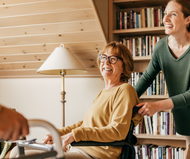December 19, 2024
How to Create a Safe and Accessible Home for Elders
1. Assess the Current Home Environment
Start by evaluating the existing home for potential hazards and areas that may require modifications. Look for issues like:
- Slippery floors
- Poor lighting
- Uneven surfaces
- Hard-to-reach storage spaces
Consider consulting an occupational therapist or a professional home safety expert for a thorough assessment.
2. Improve Accessibility
To make the home more accessible, focus on eliminating barriers that can impede movement and comfort. Key changes include:
- Install Ramps: Replace or supplement stairs with ramps to ensure easy entry and exit.
- Widen Doorways: Accommodate wheelchairs or walkers by widening door frames to at least 32 inches.
- Add Grab Bars: Install grab bars in bathrooms near toilets and showers for added support.
3. Enhance Bathroom Safety
Bathrooms are one of the most accident-prone areas in a home. To minimize risks:
- Use non-slip mats in and around the shower or tub.
- Install a walk-in bathtub or shower with a built-in seat.
- Opt for lever-style faucets for easier use.
- Consider a raised toilet seat for added convenience.
4. Focus on Lighting
Good lighting is crucial for preventing falls and ensuring visibility. Suggestions include:
- Install bright, energy-efficient lighting in hallways, staircases, and outdoor areas.
- Use motion-sensor lights for convenience.
- Reduce glare by using frosted bulbs or diffused lighting.
5. Make Flooring Safe
Flooring can contribute to trips and slips, so:
- Remove area rugs or secure them with anti-slip pads.
- Opt for slip-resistant flooring materials like vinyl or cork.
- Keep floors clutter-free to reduce tripping hazards.
6. Adapt the Kitchen
A senior-friendly kitchen should prioritize safety and ease of use. Ideas include:
- Lower countertops and cabinets for easy access.
- Use pull-out shelves and lazy Susans to reduce reaching.
- Opt for appliances with clear, easy-to-read controls.
7. Create a Comfortable Bedroom
A bedroom should be a restful and safe space. Adjustments include:
- Choose a bed at an accessible height.
- Keep essential items like phones and medication within arm’s reach.
- Install bedside lighting with easy-to-operate switches.
8. Ensure Emergency Preparedness
Safety also involves being prepared for emergencies. Steps to take:
- Install smoke and carbon monoxide detectors and test them regularly.
- Provide seniors with wearable medical alert devices.
- Create an emergency plan, including contact numbers and evacuation routes.
9. Incorporate Smart Technology
Modern technology can significantly enhance safety and convenience:
- Install smart home systems for remote monitoring.
- Use video doorbells and security cameras for added security.
- Set up voice-activated devices for easy control of lights, thermostats, and appliances.
10. Encourage Personalized Touches
Finally, while safety is essential, the home should still feel welcoming and familiar. Incorporate personal touches like family photos, cherished furniture, or favorite colors to make the space warm and inviting.
Creating a safe and accessible home for elders is a vital step in supporting their independence and quality of life. By assessing their needs, making thoughtful modifications, and incorporating modern conveniences, you can ensure their living environment is both secure and comfortable. Start planning today to provide your loved ones with a home that truly meets their needs as they age.

